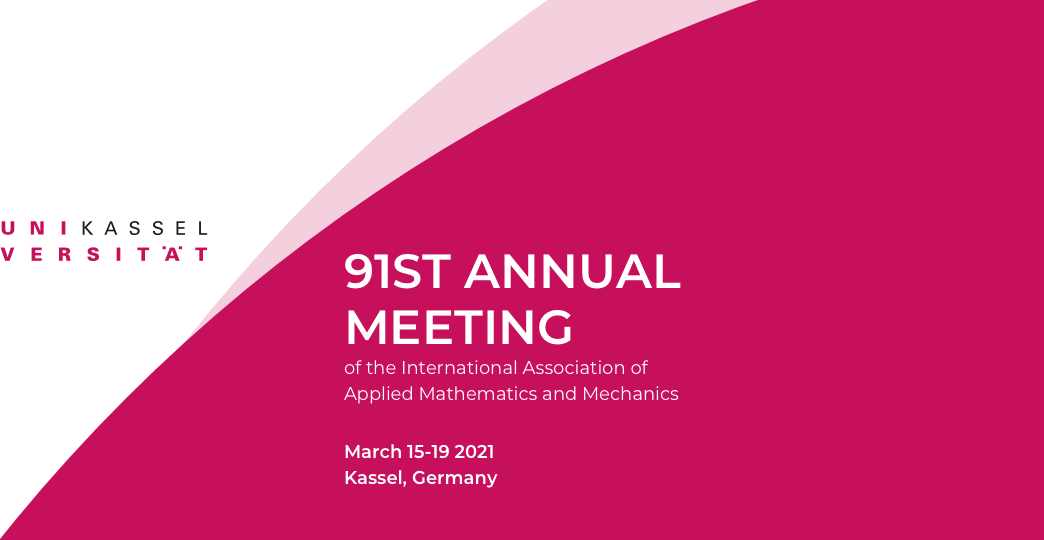Kassel
Once Upon a Time…
…the Brothers Grimm (Jacob 1785-1863 and Wilhelm 1786-1859) lived in Kassel. They attended a school in Kassel: Friedrichsgymnasium. After studying in Marburg they lived with interruptions in Kassel. Jacob worked as a librarian for Napoleon’s brother Jérôme Bonaparte, who was head of the Kingdom of Westphalia between 1807 and 1813 which mad Kassel its capital. Jérôme Bonaparte was called lovingly „König Lustik“ (King funny) by the population of Kassel, making fun of his French pronunciation. Wilhelmshöhe Palace was called Napoleonshöhe at that time. But Jérôme lived at first in the City Palace which was at that time where the Regierungspräsidium is situated nowadays. It burned down in 1811, only a staircase reminds of its former presence. Jacob Grimm as a librarian is said to have run into the burning palace to save some of the valuable old books from the library.
For a long time the Brothers Grimm lived in the building of the “alte Torwache” at the beginning of Wilhelmshöher Allee. In front of that house you can find a small monument of the Brothers Grimm (1985). Another relict from Kassel’s era as a residential city is the porticus of the Red Palais (built between 1821 and 1826). The palace itself burned down after a bomb attack of the Allied Troops in 1941, only the porticus was restored after the war and was integrated into the building of a warehouse at that site. Since documenta IX in 1992, there is a group of figurines on top of the porticus called “The Strangers”. This artwork was made by Thomas Schütte.

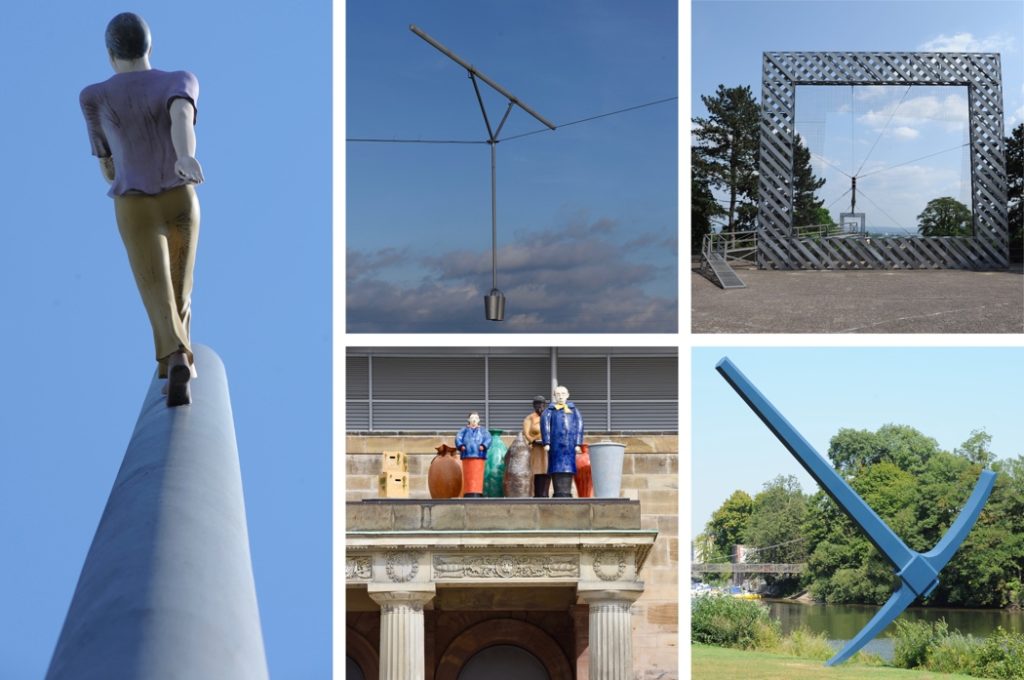
In 1806 the Brothers Grimm had started collecting German fairy tales which they published between 1812 and 1858 as “Kinder- und Hausmärchen”. Today, a copy of the first edition can be found in the Grimmwelt in Kassel. Dorothea Viehmann (1755-1815), the daughter of a French-Hugenot family, living in Kassel Niederzwehren at that time was one of the main sources for the Brother Grimm’s collection of fairy tales. Today you can find a statue of the “Viehmännin” in Kassel Niederzwehren.
It was only in 1961 that one of the German linguistic large scale projects of the Brothers Grimm was finished: the German Dictionary. It is a collection of all terms of the German language, defines them and gives evidence of them from examples of the German literature. It took so much more time than they would have expected and accordingly Wilhelm died when they were working on letter D and Jacob’s last entry was the word “FROTEUFEL”. In Kassel’s Grimmwelt you can find an artwork by Ecke Bonk (*1953) called “Book of Words / random reading” which he created for documenta 11 (2002) to honour this monumental part of the Grimms’ work.
The documenta, which is around the globe celebrated as most important exhibition of contemporary art, takes place every 5 years in Kassel and lasts for 100 days. Arnold Bode, an art professor from Kassel (to whom the University of Kassel dedicated a street name on campus), had the idea that led to the first documenta in 1955. After the end of the War he wanted to place contemporary art works that had been discriminated against as “entartet” by the Nazi-Regime into a new, appreciative light And in the grey debris of post-war Kassel – 70 % of which was destroyed by the bombings of the Allied Troops – they were meant to bring new colour and life to Kassel, together with the exhibits of the national garden show (BUGA) that was simultaneously taking place in the city.
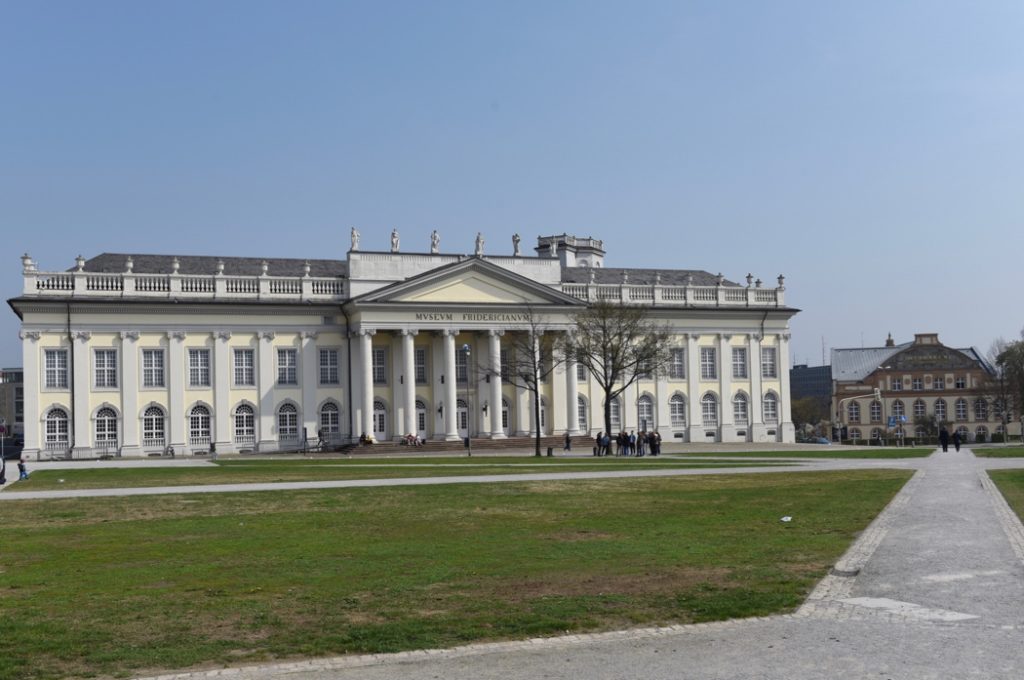
The documenta and its artworks have always led to controversies and wild discussions in the city and its population. Nevertheless, many artworks have been bought by the city, by private investors or even by collecting money in the population and are now an integral part of the cityscape.
During documenta 7 (1982), for example, Joseph Beuys piled up 7000 basalt steles in front of Museum Fridericianum and asked people to help him plant an oak trees besides each of the steles. The artwork “7000 oaks” was meant to be a “social sculpture”. Up to today many people in Kassel identify with their trees (not only oaks though) and take care of them. Joseph Beuys had planted the first oak in front of “Museum Fridericianum”, in 1987. His wife and son completed the artwork by planting the 7000th oak at its side during documenta 8. Joseph Beuys himself had died in 1986. The trees can be found in many streets of Kassel, in private gardens, on school grounds, and even on Campus. You can recognize a Beuys tree by the stone.
Another famous documenta artwork is to be found in front of Kulturbahnhof Kassel, the “Man walking to the sky” by Jonathan Borofsky, from documenta IX (1992). The people of Kassel call it tenderly “Himmelsstürmer” (Sky-Striker).
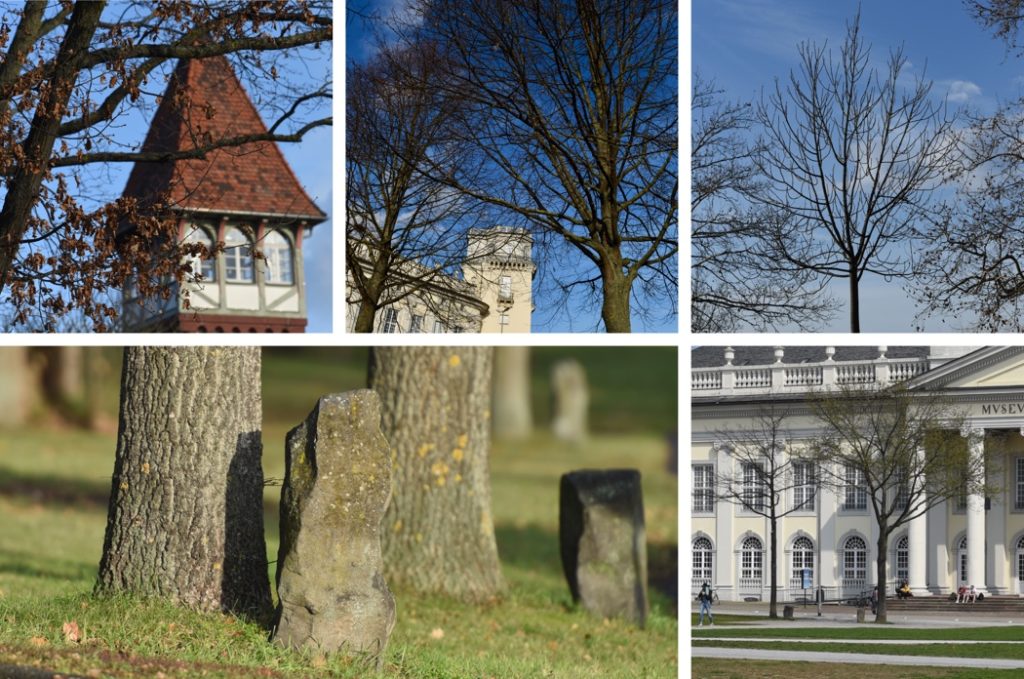
In The Meadows of River Fulda (Karlsaue), you can find a huge pickaxe at the Banks of the River Fulda. A modern legend tells that Hercules has thrown it down from his position in the mountain park to help the people of Kassel reconstructing the city from the debris of WW II. Claes Oldenburg is responsible for the artwork which was part of documenta 7 (1982).
Next to the building of Kassel Staatstheater you can find a huge framework, an artwork of documenta 6 (1977), which is called “Rahmenbau” (frame-like build) or “Landschaft im Dia” (landscape within a slide) and was made by a group of architects and artists called Haus-Rucker-Co. It is meant to stress the opening of Friedrichsplatz towards the landscape of the Aue-Park. Up to 1907, there had been an Aue-Gate at this site, that was interpreted as a window to the landscape. In 1909 it was replaced by the huge building of the old Prussian theatre that blocked the view. This building was partly destroyed during WW II and later not restored but replaced by a new theatre building at a slightly different position. This decision is still discussed every now and then in Kassel’s local newspaper.
Most of Kassel’s old city – that consisted mainly of timbered houses – burned down in the bombings of the Allied Troops in WW II. Accordingly, only very few buildings report from the medieval city of Kassel. Brüderkirche and Renthof (as part of an old Carmelite monastery) date back to the 13th century and are considered to be the oldest buildings of Kassel. Both buildings are in gastronomical use nowadays. Close by there is another historical building from the 16th century. It used to be the royal stables but since 1965 it has been used as a market hall where you can buy fresh vegetables, and other local farming produce and find small restaurants and cafés every Thursday and Saturday morning.

Bergpark Wilhelmshöhe, a unique landscape park that dates back to 1696, with its famous waterworks – that were completed in 1714 – and the statue of Hercules (1701-1717) has recently been proclaimed a UNESCO World Heritage. In the summer months (starting May 1st, ending October 3rd) the water games can be seen on Wednesdays and Sundays. They start below the Hercules monument, pass through all the park and end in a huge fountain in front of Wilhelmshöhe Palace. Without electronic, with no pumps, merely mechanically by using the slope and mechanic water gates that have to be run by hand the cascades, the Steinhöfer waterfall, the Teufelsbrücke (devil’s bridge) and the artificial ruin of an aqueduct are included into the water performance. The water that is used is rain and surface water that is collected in huge reservoirs on top of the mountain hidden behind the Hercules monument
Bergpark Wilhelmshöhe is a unique landscape park referring to different traditions of gardening and landscape construction, e.g. elements of the Baroque tradition with symmetrical structures and the idea of subordinating nature to ratio and elements of romantic landscape gardening with winding paths and Löwenburg which was built as simulacrum of a ruin of a medieval castle.
In Wilhelmshöhe Palace (1786) you can find a gallery with a respectable collection of old masters like Rembrandt, Rubens and Franz Hals. In its Weißenstein wing you can find a museum with historic furniture.
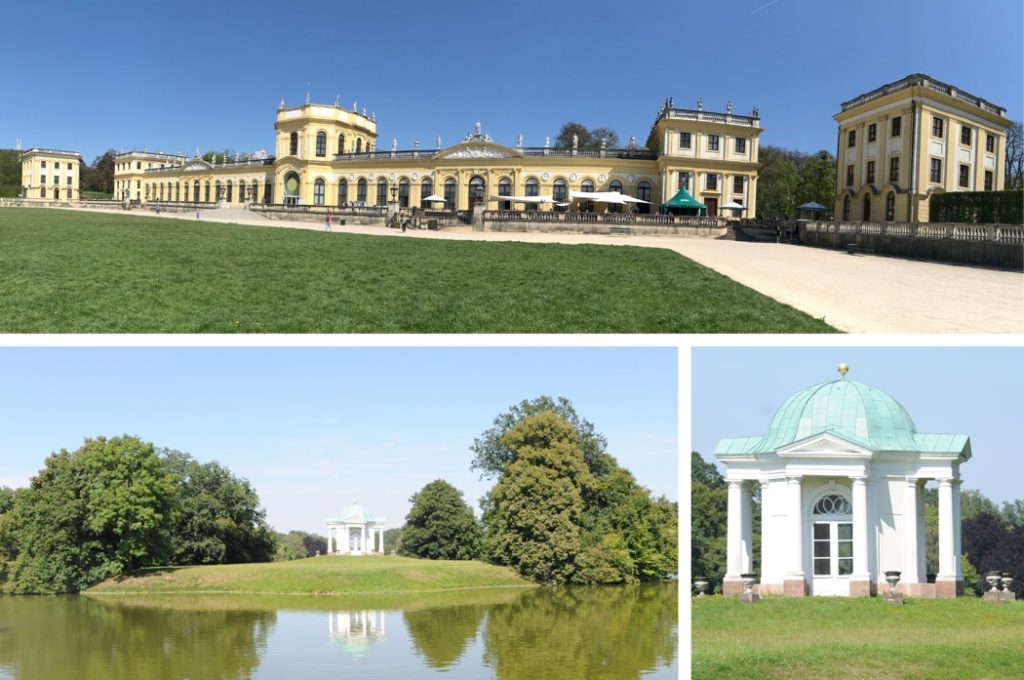
Close to Friedrichsplatz the Gustav-Mahler-Staircase leads to the Karlsaue, a huge meadow park along the banks of river Fulda that stretches up to the Aue-Stadium. In the centre of this national park with baroque origin you can find an old orangery (built between 1703 and 1711), a baroque palace which is used as an astronomical-physical cabinet with a planetarium.
Drahtbrücke (which translates as “wire bridge”) dates back to 1870 and is a pedestrian suspension bridge that traverses the Fulda within Kassel city to connect parts of the new city (Unterneustadt) with the old centre.

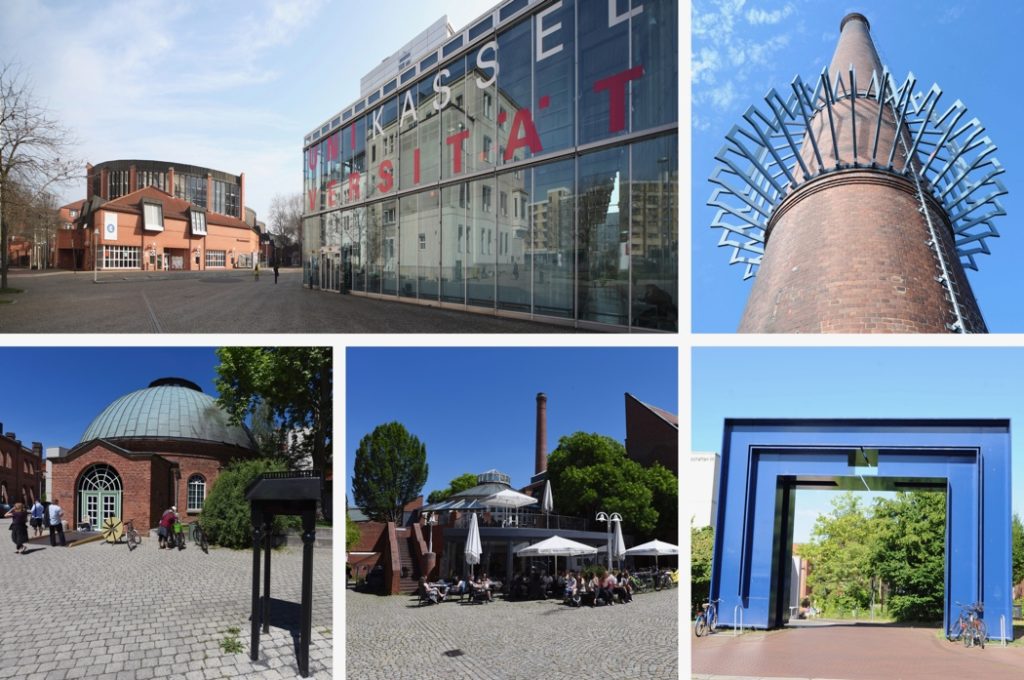
Kassel University’s Campus “Holländischer Platz” was built after WW II on the old site of the Henschel factory. Up to 1972 locomotives, machines and waggons had been constructed there. Some of the old red brick industrial buildings show traces of this era. Some of them like the former foundry (Gießhaus) were refurbished or even completely gutted and restyled like the building opposite Gießhaus that shows only the façade of the red brick building as a ruin. Especially Gießhaus is an architectural gem on the university campus and only used for special events.
A red brick Chimney and the building of the administration of the Henschel factory (K10) – which is now used by the department of architecture – are kept as memory of the former use of the area, other buildings were torn down. In the 1980s some new red brick buildings were built on campus. At that time Kassel as a Gesamthochschule wanted to be referred to the British “Red Brick Universities”. In the centre of this campus you can find the library as the “core” of the university. In the following years the campus was extended with buildings of different architectural styles. In 2002 Gesamthochschule Kassel became Kassel University.
The Henschel factory was one of the reasons why Kassel became such an important a target of the Allied bombing in WW II. The blue gate in Georg-Forster-Straße, an artwork by Eberhard Fiebig called “Tor des irdischen Friedens” (gate of earthly peace) (1986) indirectly refers to this part of the history of the campus. More directly another sculpture or memorial reminds of the horrors of the Nazi regime: E.R. Neles “Die Rampe” (the ramp) (1985) recalls the practice of deportation. The Henschel factory had also employed forced laborers during the war.
During the 91st GAMM’s annual meeting three guided tours, at which participants will experience the art, culture and history of the documenta city Kassel, are offered. The tours will be guided by Catrin Siedenbiedel. She is head of the “Pre-service Teaching Office“ in the Center for Teacher Education at the University of Kassel. Her great expertise in art, culture, history and literature is based on her doctoral thesis in English literature.
The guided tours will start on Tuesday, Wednesday and Thursday at 13:30 in the foyer of the Campus Center close to the information desk. The arrangement of the tours will depend of the weather. Please expect a time frame of about four hours. The tours are free of charge, you are merely asked to pay for your tram and entrance tickets, and for café visits.
| Tuesday, March 16 | Schloss Wilhelmshöhe and Bergpark Wilhelmshöhe Tour 13:30 – 17:30 Meeting Point Campus Center |
| Wednesday, March 17 | Brother Grimm Tour 13:30 – 17:30 Meeting Point Campus Center |
| Thursday, March 18 | City of Kassel Tour including documenta Art, Orangerie and Karlsaue 13:30 – 17:30 Meeting Point Campus Center |
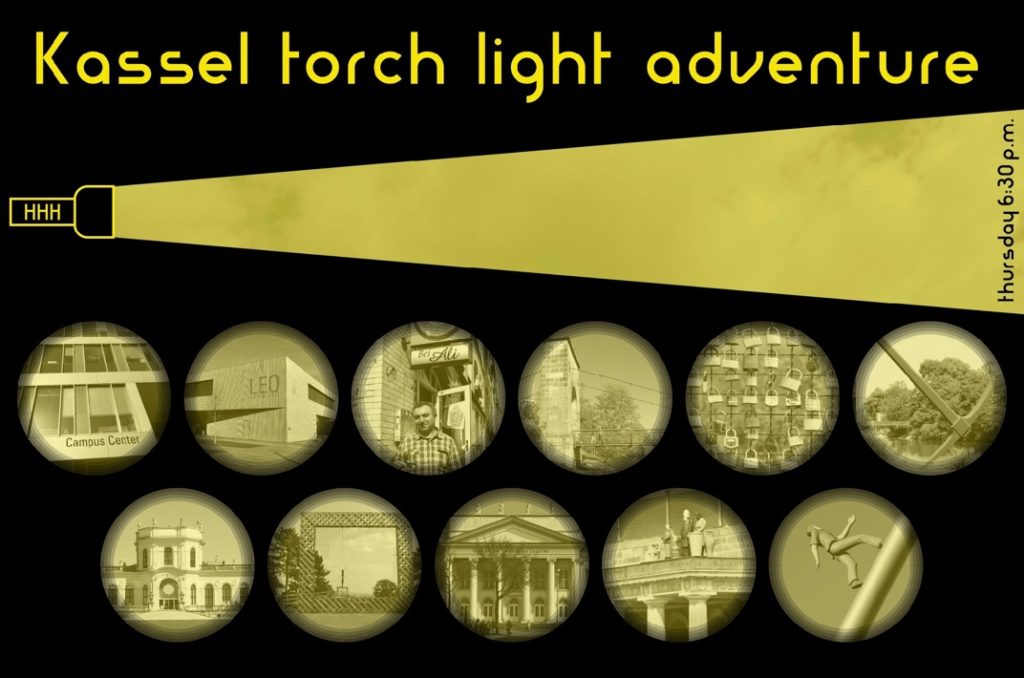
Kassel torch light adventure
The ‘Kassel torch light adventure’ is a guided night walk through the University of Kassel and Kassel as documenta city. The special tour will take place on Thursday in the evening after the last presentation of annual meeting of GAMM 2020 will have been rewarded with a big hand. The tour will be guided by Hartmut Hetzler, a member of the local board of the 91st GAMM’s annual meeting and a great expert on the history and modern day and night life of the documenta city Kassel. He will guide you through the special facilities of the University of Kassel, the north part of the city where students and residents live together in peace and friendship. After the first short break at Ali’s kiosk, the tour will proceed with some historical, cultural highlights including some documenta art work. Of course, some surprises will be waiting for you in the deep darkness of Kassel’s night life. The tour will officially end at the sculpture ‘man walking to the sky’ created by the American artist Jonathan Borofsky (Rainer-Dierichs-Platz 1, Kassel).
Some torch lights will be provided by your tour guide and the conference chairman. However, if possible, please bring your own lights with you. Furthermore, please wear robust shoes and, if necessary, a cagoule. Because of the special style of the tour, the number of participants is limited by fifty. Please register for the gratuitous Kassel torch light adventure at the conference info desk of GAMM 2020. If you would like to join Hartmut Hetzler after the walk for dinner in his favorite restaurant, please accept an additional fifteen minutes walk and register for this dinner at latest on Wednesday March 17 at the info desk. Please notice that attendees should pay by themselves for food and drinks.
